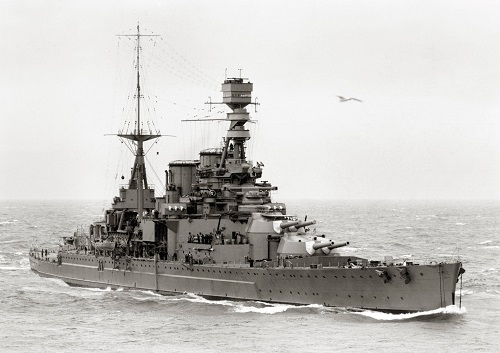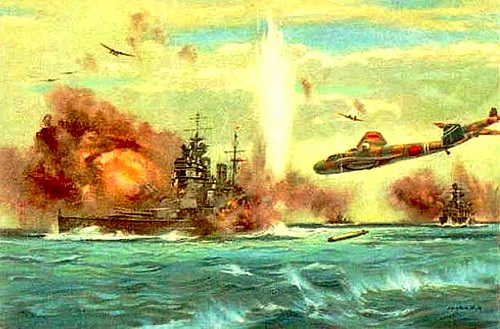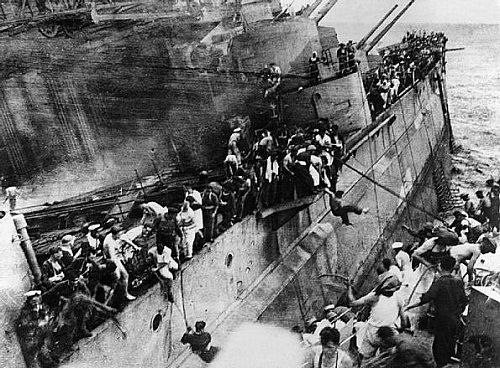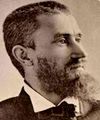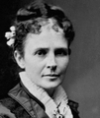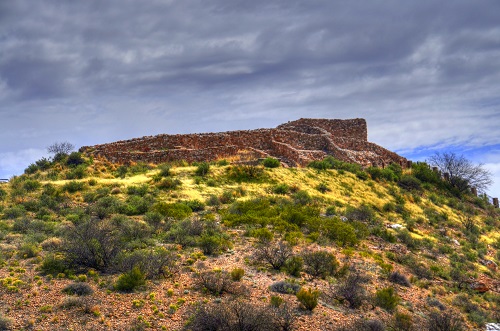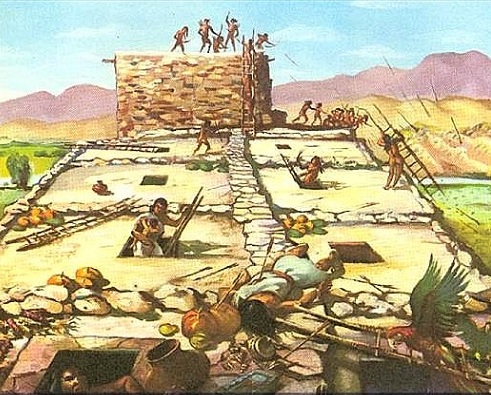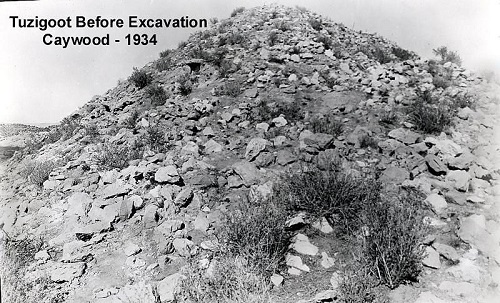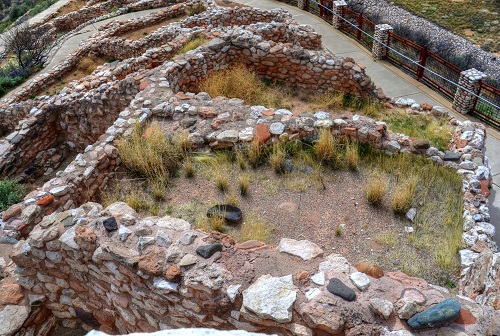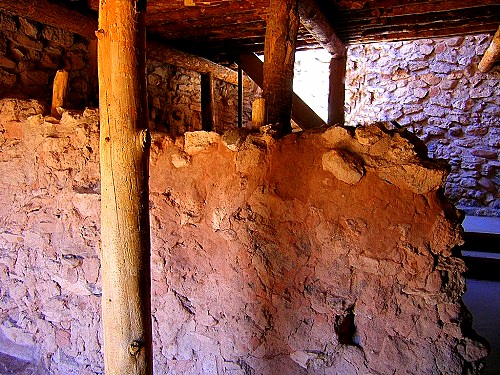NOTE TO READERS: In keeping with our philosophy of lifelong learning, we are now on Twitter as @cachemaniacs. If you’re interested, there’s a Twitter follow button over on the sidebar or you can just click the link above.
Hi again,
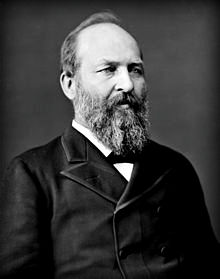
President James Abram Garfield
20th President
Born: November 18, 1831
Inaugurated: March 4, 1881
Shot: July 2, 1881
Died: September 19, 1881 (age 49)
Time in Office: 200 days
I know what you’re thinking. C’mon Boris. The James A. Garfield NHS? Y-a-a-a-a-w-w-w-n. The same thought occurred to us when we visited recently. We needed a break on our annual pilgrimage to Pennsylvania and this sleepy little suburb east of Cleveland was in just the right place. Besides it had a National Passport Stamp and a couple of munzees and geocaches to boot. We figured we’d do our collecting, take a quick look around and be on our way in 30 minutes. We stayed several hours. It’s a very cool place and our 20th President was an interesting and admirable man.
Information about James Garfield often includes the phrase “self-made man” and he certainly was that. The youngest of five children, he was born in a log cabin and raised in abject poverty by his widowed mom, Eliza. Despite the hard scrabble upbringing, he became a highly educated and successful man. He was a college professor, ordained minister, lawyer and Civil War veteran all by the age of 30. He spoke several languages, could write in two languages simultaneously with both hands and was one of the most gifted orators of his day. So naturally, all of this led him to his real calling – politics. After two years as an Ohio State Senator, he set his sights on the United States Congress.
**Historical footnotes: Garfield was the last of seven Presidents to be born in a log cabin. He was the first left-handed President, the only ordained minister to serve in the office and the only candidate to be elected President straight from serving in the House of Representatives. Last but not least, he was the first President to have his mother attend his inauguration.**

The house that’s there now bears no resemblance to the one that 14 year Congressman James A. Garfield bought in 1876. He had always wanted a farm to be near his constituents, raise his growing family and escape the heat and politics of mosquito-ridden Washington, DC during the lengthy legislative breaks. He found it in Mentor, Ohio not far from the shore of Lake Erie and less than 20 miles from his childhood cabin in Moreland Hills. Along with 158 acres of land came a ramshackle 1 1/2 story nine room white clapboard farmhouse built in 1831. Before long, crops, livestock, orchards and voters were being tended to and the house was getting renovated. This is the eastern side of it. The Garfield family always referred to it as the Mentor Farm. Since livestock roamed and grazed all the way up to the house, the press soon dubbed it “Lawnfield”.
Garfield had a new family, successful law practice and political ambitions when the Civil War broke out. Nevertheless, he was determined to do his part. He was a staunch abolitionist who openly advocated a scorched earth war against the Confederacy, whom he considered traitors. He could have taken a safe job far removed from the fighting and still checked the veteran’s block on his political resumé, but he didn’t. Despite having no military background, he wanted a combat command. Initially commissioned a Lieutenant Colonel in the Ohio militia, he was put in command of a brigade and sent to Eastern Kentucky, where the Confederates were recruiting and establishing a foothold. His orders were to clear them out.
On January 10, 1862, Garfield’s brigade attacked and defeated a larger rebel force at the Battle of Middle Creek near Prestonsburg, KY. It wasn’t a big battle but it was important for two reasons. One, it gave the Union a victory when they really needed one. Two, President Lincoln was profoundly grateful that his home state hadn’t been hijacked by the Confederates. Garfield’s star was rising and he became the youngest General in the Union Army. Fighting at Shiloh, Corinth and Chickamauga, he acquitted himself well in those actions, earning his second star as a Major General. For the rest of his life, he was referred to by everyone as General Garfield or simply “the General”.
While on medical leave in the fall of 1862, he ran for Congress in his home district (Ohio 19th) and won easily. He returned to the fighting while also carrying out congressional duties. After Chickamauga in September 1863, he resigned his commission at Lincoln’s behest and assumed his elected office. Despite his earlier rapport with President Lincoln, Garfield refused to support his re-election in 1864 because he thought Abe wasn’t being aggressive enough in the war.
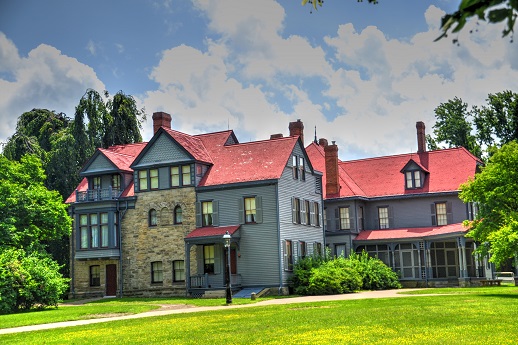
The structure of the old house is built into the current one. The clapboard section with the small porch in the foreground is part of the original farmhouse. If you take the inside tour, the ranger will point out walls, doorways and stairwells that were also part of it. The house was under continuous renovation for years under the direction of Garfield’s wife Lucretia. It has a mix of styles, including Victorian, Tudor and Cape Cod, all of which can be seen in the picture above. It soon grew to 20 rooms housing their seven children and close relatives from both sides of the family. It also had running water and natural gas for heat, light and cooking. The water and gas came from wells on their property which can still be seen today, although they are no longer in use. After Garfield’s death, Lucretia added an ornate library with a room-sized steel vault on the third floor. It became the very first Presidential Library and is still there today.
Another term you’ll hear to describe Garfield is “dark horse” and he is that, too. It refers to his surprise nomination for President at the 1880 Republican Convention in Chicago. After 36 ballots, none of the listed candidates could corral enough votes. Garfield’s name was placed in nomination as a compromise and the other candidates released their voting blocs. He was nominated on the 37th ballot.
**Historical footnote: The 37 ballots at the 1880 Republican Convention is still a record for the party. The Democratic record is an unbelievable 103 ballots at the 1924 convention in New York that dragged out for three weeks. That nominee was John Davis, a prominent lawyer and diplomat. He lost to the Republican incumbent Calvin Coolidge.**
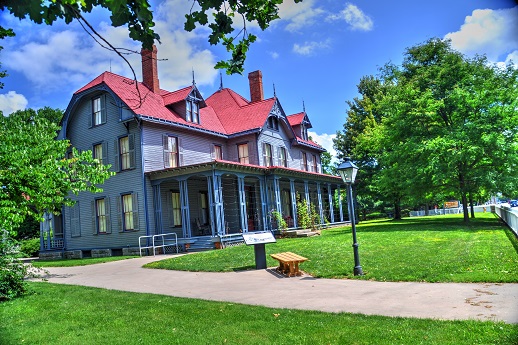
On this front porch at the southwest corner of the house, James Garfield changed the way Presidential candidates campaign for office. In prior Presidential elections dating back half a century or more, a protocol had been observed that the candidates didn’t do much campaigning and didn’t talk about themselves. It was considered unseemly and undignified. They let their colleagues, friends and others speak for them. Garfield thought that was crazy, especially since he was a better speaker than anyone in his circle. On the other hand, he didn’t want to ruffle any feathers by turning conventional wisdom upside down. Thus was born “The Front Porch Campaign”. Instead of the candidate running around making speeches, the people came to him. People showed up at Lawnfield from all over the country to hear Garfield talk about the issues of the day and mingle with the crowd, which sometimes numbered in the thousands. Presidential campaigning (and governing) was up close and personal. Schedules were published in the paper. There were no body guards. No security whatsoever. It was perfectly acceptable for a person to walk up to a candidate – or even the President himself – anytime, anywhere and ask questions or air grievances. Candidate Garfield liked to work the farm and often had people – total strangers – walk up to him in the fields and barns to talk politics. Garfield gave dozens of front porch speeches in the summer and fall of 1880. Parts of them he did in German, since many of his supporters were German immigrants. He mingled with thousands of people. In the end, he was successful. Future Presidential candidates would use this model very effectively and eventually strike out on the campaign trail themselves.
**Historical footnote: Garfield also brought another innovation to campaigning. In a small shack behind the house that served as his campaign headquarters, he had a dedicated telegraph line installed and hired people to man it 24 hours a day. Dispatches came and went night and day as the Garfield campaign pioneered the use of communications media.**
His Democratic opponent was retired Union General Winfield Scott Hancock, the “Hero of Gettysburg”. Defying the odds, Garfield threw himself into campaigning and won by the narrowest of margins – about 1/10 of one percent. The self-made man, dark horse and master of Lawnfield was now the 20th President of the United States.
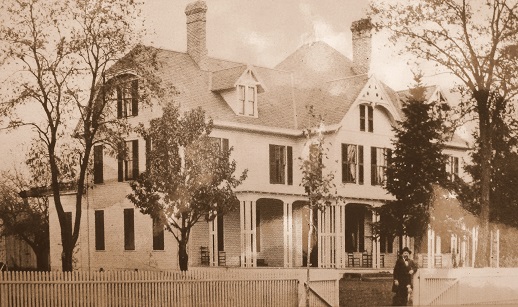
This picture of President-elect James Garfield was taken sometime before he left for his inauguration on March 4, 1881. He would never see Lawnfield again.
**Historical footnote: The Constitution originally mandated March 4 of the year following an election for the Presidential Inauguration. March 4 was chosen because that is the birthday of the Constitution – March 4, 1789. That changed in 1933. The 20th Amendment designated January 20 as Inauguration Day.**
Garfield became President in the early years of the “Gilded Age”, a time of unprecedented growth in America lasting from the 1870’s until the turn of the century. The issues he faced were right out of today’s headlines – corruption, labor unrest, immigration, civil rights and economic opportunity. It was the time of the “Robber Barons” – the Rockefellers and Carnegies, the Morgans and the Mellons. It was also the time of the big city political machines like Boss Tweed and Tammany Hall. Throw in labor unions, Indian wars and the first rumblings of prohibition and women’s suffrage and you have your work cut out for you.
His most immediate priority was stopping the onerous White House patronage system of staffing civil service jobs. In years gone by, people would line up outside the White House for an audience with the President seeking a job in the new government. Garfield believed that people should be hired for their abilities and fitness for the job. He immediately shut down the job line and sought the development of a merit based civil service selection system.
In that job line was a schizophrenic lawyer named Charles Guiteau. His family had him committed to a mental institution in 1875 but he had gotten loose at some point. Now he sought a career as a diplomat in the new administration as a reward for his campaign support. Guiteau hung around the White House and the State Department for weeks and even had a meeting with the President. Finally, in May, he was banished from both places and told never to return. The voices in his head told him to kill President Garfield. He bought a .44 caliber revolver and with the aid of the daily White House schedule published in the newspaper, began stalking the new President.
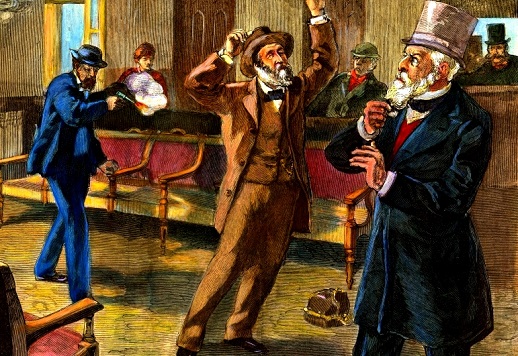
On July 2, 1881, President Garfield went to the Sixth Street Station of the Baltimore and Potomac Railroad about ten blocks from the White House. His destination was a speech at his Alma Mater – Williams College in Massachusetts followed by some vacation time in New England. With him were two teenaged sons and Secretary of State James Blaine. Also at the station to see them off was Robert Todd Lincoln, the Secretary of War and the son of Abraham Lincoln. As usual, there was no security, even though Guiteau had announced his intentions for weeks through letters to cabinet officials, military officers and Republican Party leaders. When the President arrived in Blaine’s horse and buggy, Guiteau was waiting inside. As Garfield walked into the waiting area at 9:30 A.M., Guiteau stepped up close behind him and shot him twice at point blank range. The first bullet grazed Garfield’s right arm. The second entered the President’s back on the right side by the first lumbar vertebra, lodging near the pancreas. It missed the spinal cord and vital organs. Guiteau was immediately apprehended. He’d seen his last sunrise as a free man, but he wasn’t an assassin yet. The President was still alive.
**Historical footnote: Garfield was alive but he would not govern again. His governing tenure lasted 120 days although his official time in office is 200 days. The only President to serve a shorter time was William Henry Harrison, the 9th President. He died of pneumonia on April 4, 1841 after only 30 days in office.**
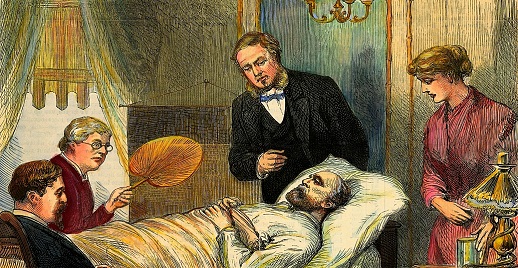
At his trial, Charles Guiteau admitted shooting Garfield but contended his doctors killed him. That’s also the historical hindsight concensus of the post-shooting care the President received. It was downright medieval and he suffered horribly. He lingered for 80 days while doctors poked and prodded with their fingers trying to find the bullet, which they never did. All they accomplished was to set off rampant systemic infection throughout his body. To cool his fever, he was moved to Elberon, NJ, a resort town on the coast. Garfield lost 80 pounds in 80 days as his doctors tried to feed him a concoction of raw eggs and whiskey to improve his constitution. Finally on September 19, 1881 – wasted away to almost nothing, wracked with fever and draining infection from every orifice in his body – President James Garfield died. He was 49. His wife Lucretia was at his side as she had been the whole time.
**Historical footnote: Despite this second assassination of a sitting President, there was no action taken to protect them. It would take the assassination of a third – William McKinley in 1901 – to get the federal government to deal with it. The task fell to the Secret Service, which was created to chase counterfeiters after the Civil War. The law creating the Secret Service was signed by Abraham Lincoln on April 14, 1865 – the day he was assassinated.**
Upon Garfield’s death, his Vice-President Chester A. Arthur took office as the 21st President and finished out the term. He declined to run for a term of his own in 1884. Grover Cleveland, the Democratic Governor of New York, became the 22nd President that year.
Charles Guiteau went to the gallows on June 30, 1882 – two days before the first anniversary of the shooting. He turned his trial into a circus, exhibiting bizarre, irrational behavior never seen before in such a high profile public venue. He was convinced until the end that he would be released and was planning a lecture tour.
Lucretia Garfield buried her husband at Lake View Cemetery in Cleveland, then returned to private life at Lawnfield. Since there were no government pensions or support, benefactors set up a trust fund for her that totaled almost half a million dollars. This enabled her to live a quiet, comfortable life until her death in 1918 at the age of 85. She is buried with her husband.
The house remained in the Garfield family for another five decades. After Lucretia’s death, her brother Joseph lived in it until he died in 1934. During the years after her husband’s death, Lucretia began selling parts of the farm as the Cleveland metro area moved outward. When she died, the children continued. By the 1930’s, it was down to eight acres. The current site is five acres.
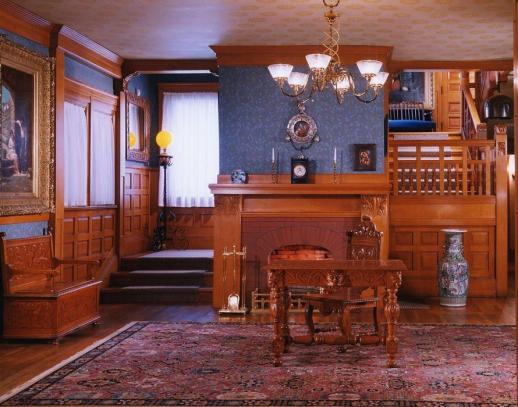
In 1936, the Garfield children donated the house and all its furnishings to the Western Reserve Historical Society. In 1980, it became a National Historic Site and the Park Service took over. A 12 million dollar restoration project in the 1990’s restored the house to its turn of the century glory, which is what you see today. Over 80% of the furnishings in the house are the originals owned by the Garfields. It’s a magnificent work of art, style and architecture. This is the formal entryway into the house.
As we explore off the beaten path, we continually run into things that are interesting and educational beyond our expectations. The James A. Garfield National Historic Site is certainly one of those places. If you find yourself in the Cleveland area, take an hour or two and pay it a visit. It’s located at 8095 Mentor Ave, Mentor, OH 44060. Here’s the park web site.
Cheers …. Boris and Natasha



